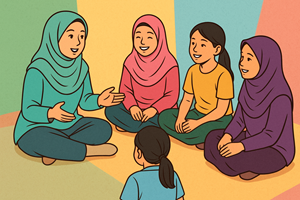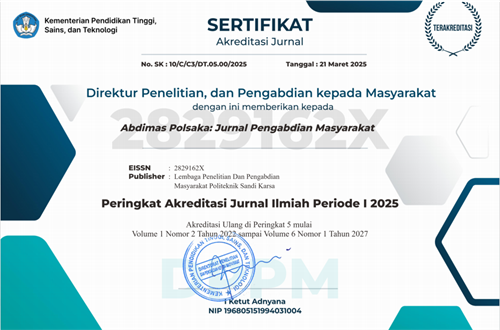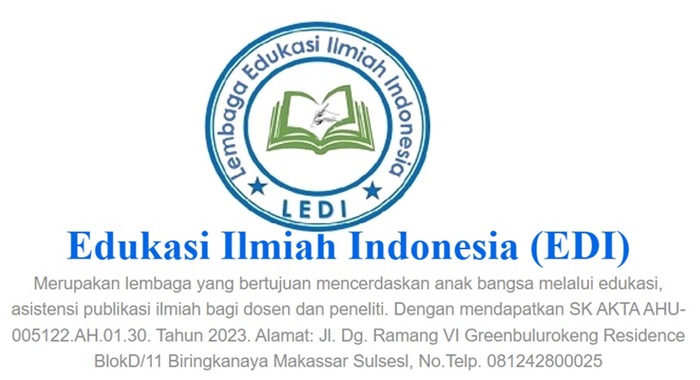Rehat Dulu: Healthy youth mentoring for boarding school girls group at Muhammadiyah 2 senior high school
DOI:
https://doi.org/10.35816/abdimaspolsaka.v4i2.99Keywords:
Boarding School Girls, Healthy Teenagers, MentoringAbstract
Adolescence is a colorful and dynamic period, accompanied by a series of emotional upheavals that adorn the journey of a human being about to grow up. Adolescents, the largest age group in the Indonesian population structure, are the focus of attention and a strategic intervention point for human resource development. The most important step that must be taken is to increase attention to adolescent girls, because they face greater risks and are more vulnerable to the social environment. In addition to being the largest group (23% of the total population), adolescents have never received comprehensive and consistent attention. The group of adolescents who are in Islamic boarding schools or pondok environments, also known as boarding schools, are groups that often receive less attention, especially in terms of health. Reproductive health and mental health in adolescent girls are issues in Islamic boarding schools or pondok environments. Reproductive health is a state of perfect physical, cognitive, and social health, not only in the absence of disease or disorders, but also in terms of sexual and reproductive well-being. This includes the right of every individual to have a safe, satisfying, and fulfilling sexual life, as well as the right to have the ability to reproduce and the freedom to decide their own will in terms of reproduction without discrimination, pressure, or coercion. Adolescent reproductive rights are increasingly becoming an important topic to study in the modern era. This community service program aims to provide health education on reproductive health, mental health, and PHBS through "take a break" assistance. The purpose of implementing this program is for groups of students to be independent and effective in improving their health status through increased knowledge and changes in good practices, as a result of the program in the form of improving the quality of services to the community (groups of students) and scientific publications.
Downloads
References
A. Diananda, “Psikologi Remaja Dan Permasalahannya,” J. ISTIGHNA, vol. 1, no. 1, pp. 116–133, Jan. 2019, doi: https://doi.org/10.33853/istighna.v1i1.20.
R. Z. Uktamovna, “The transformative journey of adolescence: a study of the physical, cognitive, emotional, and social changes during the teenage years,” Spanish J. Innov. Integr., vol. 39, pp. 169–172, 2025.
M. Wulansari et al., “Healthy adolescents free of anemia in iyok village, north bolaang mongondow regency,” Abdimas Polsaka, vol. 4, no. 1, pp. 43–39, Mar. 2025, doi: https://doi.org/10.35816/abdimaspolsaka.v4i1.89.
T. Reimer, “Environmental factors to maximize social media engagement: A comprehensive framework,” J. Retail. Consum. Serv., vol. 75, p. 103458, Nov. 2023, doi: https://doi.org/10.1016/j.jretconser.2023.103458.
S. Choukas-Bradley, S. R. Roberts, A. J. Maheux, and J. Nesi, “The Perfect Storm: A Developmental–Sociocultural Framework for the Role of Social Media in Adolescent Girls’ Body Image Concerns and Mental Health,” Clin. Child Fam. Psychol. Rev., vol. 25, no. 4, pp. 681–701, Dec. 2022, doi: https://doi.org/10.1007/s10567-022-00404-5.
Y. D. Arna et al., Problematika Kesehatan Remaja. 2024.
W. Elsayed, “The negative effects of social media on the social identity of adolescents from the perspective of social work,” Heliyon, vol. 7, no. 2, p. e06327, Feb. 2021, doi: https://doi.org/10.1016/j.heliyon.2021.e06327.
R. Rusmaniah, F. Mardiani, M. R. N. Handy, M. A. H. Putra, and J. Jumriani, “Social Services Based on Institutional for Youth Discontinued School,” Innov. Soc. Stud. J., vol. 2, no. 2, p. 151, Mar. 2021, doi: https://doi.org/10.20527/iis.v2i2.3082.
R. A. Jessica and E. Puji, “Knowledge about menstruation with readiness to face menarche of elementary school students in the era of reproductive health education,” J. Ilm. Kesehat. Sandi Husada, vol. 14, no. 1, pp. 174–182, Jun. 2025, doi: https://doi.org/10.35816/jiskh.v14i1.1265.
R. Vanderkruik, L. Gonsalves, G. Kapustianyk, T. Allen, and L. Say, “Mental health of adolescents associated with sexual and reproductive outcomes: a systematic review,” Bull. World Health Organ., vol. 99, no. 5, pp. 359-373K, May 2021, doi: https://doi.org/10.2471/BLT.20.254144.
A. G. Nmadu, S. Mohamed, and N. O. Usman, “Adolescents’ utilization of reproductive health services in Kaduna, Nigeria: the role of stigma,” Vulnerable Child. Youth Stud., vol. 15, no. 3, pp. 246–256, 2020. DOI: https://doi.org/10.1080/17450128.2020.1800156
R. Rollston, E. Wilkinson, R. Abouelazm, P. Mladenov, N. Horanieh, and Y. Jabbarpour, “Comprehensive sexuality education to address gender-based violence,” Lancet, vol. 396, no. 10245, pp. 148–150, Jul. 2020, doi: https://doi.org/10.1016/S0140-6736(20)31477-X.
S. Z. Putri, S. M. Bachtiar, and S. Suprapto, “A Descriptive Case Series on Combined Education, Breast Care, and Oxytocin Massage for Lactation Support in Indonesia,” J. Public Heal. Sci., vol. 4, no. 02, pp. 165–179, 2025, doi: https://doi.org/10.56741/IISTR.jphs.001030.
A. Akib et al., “Increasing knowledge and early detection of cervical cancer in women of childbearing age through IVA examination,” Abdimas Polsaka, vol. 3, no. 2, pp. 109–115, Sep. 2024, doi: https://doi.org/10.35816/abdimaspolsaka.v3i2.82.
M. Guan, “Sexual and reproductive health knowledge, sexual attitudes, and sexual behaviour of university students: Findings of a Beijing-Based Survey in 2010-2011,” Arch. Public Heal., vol. 79, no. 1, p. 215, Dec. 2021, doi: https://doi.org/10.1186/s13690-021-00739-5.
H. Herlianty, A. Abdullah, E. Sri Dahrianti, and N. Ketut Sumidawati, “Impact of reproductive health education on adolescents’ self-efficacy in maintaining reproductive health,” J. Pengabdi. Masy. Edukasi Indones., vol. 2, no. 2, pp. 70–77, May 2025, doi: https://doi.org/10.61099/jpmei.v2i2.78.
I. Irnawati and U. Marbun, “Healthy Pregnancy Preparation with Nutritional Fulfillment The Balanced One,” J. Pengabdi. Masy. Edukasi Indones., vol. 2, no. 2, pp. 78–85, May 2025, doi: https://doi.org/10.61099/jpmei.v2i2.96.
T. Cahya Mulat, M. I. Kamaruddin, and N. Nordianiwati, “Education on healthy living culture to increase children’s awareness from an early age,” J. Pengabdi. Masy. Edukasi Indones., vol. 2, no. 1, pp. 25–31, Jan. 2025, doi: https://doi.org/10.61099/jpmei.v2i1.66.
S. Suprapto and D. Arda, “Pemberdayaan Masyarakat Melalui Penyuluhan Perilaku Hidup Bersih dan Sehat Meningkatkan Derajat Kesehatan Masyarakat,” J. Pengabdi. Kesehat. Komunitas, vol. 1, no. 2, pp. 77–87, Aug. 2021, doi: https://doi.org/10.25311/jpkk.Vol1.Iss2.957.
S. Ismail, H. Sabri, H. Asari, M. Yamin, and M. M. Yunus, “Fostering Emotional and Moral Development in Islamic Boarding Schools: The Impact of Talaqqî and Ḥalaqa Traditions,” J. Pendidik. Islam, vol. 10, no. 1, pp. 13–24, Jun. 2024, doi: https://doi.org/10.15575/jpi.v0i0.35124.
R. H. S. Aisyah et al., “The Community Empowerment Policy to Lead A Clean and Healthy Life in Indonesia,” Sriwij. Law Rev., pp. 173–188, Jan. 2023, doi: https://doi.org/10.28946/slrev.Vol7.Iss1.1367.pp173-188.
W. D. Astutik, V. K. Sadiyah, and D. H. Siswanto, “Counseling on Clean and Healthy Living Behavior in Improving Public Health Levels,” J. Soc. Community Dev., vol. 2, no. 01, pp. 38–50, Mar. 2025, doi: https://doi.org/10.56741/jscd.v2i01.889.
L. Ge, J. A. De Castro Molina, H. T. Foo, R. Chua, and C. F. Ong, “Exploring the associations between health confidence, self-efficacy, health activation and healthy behaviours in primary school children,” Discov. Public Heal., vol. 21, no. 1, p. 253, Dec. 2024, doi: https://doi.org/10.1186/s12982-024-00354-z.

Additional Files
Published
How to Cite
Issue
Section
License
Copyright (c) 2025 Ardiana Priharwanti, Isrofah Isrofah, Yulis Indriyani, Eko Budi Prasetyo

This work is licensed under a Creative Commons Attribution 4.0 International License.




















